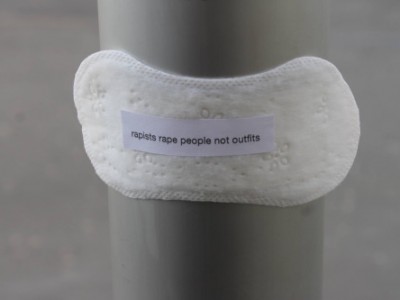 Powerful messages from a powerful girl.
Powerful messages from a powerful girl.
One message reads: “Imagine if men were as disgusted with rape as they are with periods.”
Click here to find out how Elonë is sharing her message.
Love & light,
Team ILF
 The day started off like most days, I brew a pot of coffee
The day started off like most days, I brew a pot of coffee
for my wife and I and she turns on the tv and gets ready for
work.
We were both in a great mood.
In an instant I was pissed off, angry and appalled.
Why?
Let me start by saying that I love a good joke, BUT this is NOT funny.
Not in the slightest.
It is disrespectful and the people that did this are gutless, cowards.
They are not men.
And when given the opportunity to acknowledge and apologize, they choose to dig their heals in even deeper.
I did not choose to wake up to this, but I choose to stand up and say this has to stop NOW.
So what can we men do?
When we hear or see something that makes us sick, we need to say and do something.
They need to know that is not cool or funny, and hear it from us men as well.
This is not a feminist “thing”…..it’s a respect thing.
We all need to Man up.
Author of “Life Is Sweet – Surviving Diabetes and a Whole Lot of Other Crazy Stuff!”
A poem by Samantha Reynolds of bentlily.com
Love is not fragile
Who taught you
to be sparing
with your love
as though your heart was a bank
as though love could dry up
nonsense
it is as if the ocean complained
it was too
wet
love is not fragile
it is as common as breath
it is play money
it is a race
to give more
go first
say it with impunity
you think you will ache
with vulnerability
but the strangest thing will happen
you will nearly drown
with peace.
 You can listen to the original teaching at the 110 minute mark of the Class 2 recording. You can download the audio from iTunes here or from the ILF website here.
You can listen to the original teaching at the 110 minute mark of the Class 2 recording. You can download the audio from iTunes here or from the ILF website here.
Saying NO is never easy. At the start, using a Positive NO with your “Yes! No. Yes?” is not going to be easy either. Which is why you need to practice.
We suggest that you start with the easy NOs in your life and build up your skill with delivering a Positive NO before tackling the really big NOs you know you need to be saying. Start with saying NO:
In each situation remember to use your “Yes! No. Yes?” statement and have your Plan B ready to put into action.
We would love to hear more about your experience with delivering a Positive NO. You can share your experience in the comments below…
 You can listen to the original teaching at the 80 minute mark of the Class 2 recording. You can download the audio from iTunes here or from the ILF website here.
You can listen to the original teaching at the 80 minute mark of the Class 2 recording. You can download the audio from iTunes here or from the ILF website here.
Have you delivered you first “Yes! No. Yes?” to someone? If so, congratulations! Did they accept your NO?
If they didn’t, it is time to move on to Plan B.
Plan B is a second, or back up plan that addresses your core interest and supports your original Yes! that is not dependent on the other person being involved. Plan B is not retaliation, not anger, and not a threat, Plan B is what you are going to do ANYWAYS when the other person doesn’t accept your no.
If you are clear on your Plan B, and ready to move on regardless of the other person accepting your NO, no one can stop you. Your Plan B allows you to stay true to your values and what you need without depending on the other person.
Before you make your next “Yes! No. Yes?” statement to someone in your life, make sure you have developed a Plan B that you can follow through with regardless of the response you get to your NO.
Writing down your Plan B can help make it more concrete, share your Plan B with the community in the comments below…
 You can listen to the original teaching at the 42 minute mark of the Class 2 recording. You can download the audio from iTunes here or from the ILF website here.
You can listen to the original teaching at the 42 minute mark of the Class 2 recording. You can download the audio from iTunes here or from the ILF website here.
For today’s lesson think of an example in your life where you have been accommodating, attacking, or avoiding instead of saying NO. Focus on this scenario, and do the following:
This second “Yes?” is a new option you offer to the person you just said no to. It is a plan that will work regardless of what the other person decides. It needs to be an option that you can follow through on without the other person having to agree with your NO. This “Yes?” is not a compromise, it is a solution that supports you and what is important to you.
(Make sure to listen to the recording to hear Indrani’s brownie example)
Think about your own example and write down a complete “Yes! No. Yes?” statement that you can use in your situation.
 Self Responsibility… The “Philosophical Principle (that) entails ones acceptance of a profoundly moral idea. In taking responsibility for our own existence we implicitly recognize that other human beings are not our servants and do not exist for the satisfaction of our needs.”
Self Responsibility… The “Philosophical Principle (that) entails ones acceptance of a profoundly moral idea. In taking responsibility for our own existence we implicitly recognize that other human beings are not our servants and do not exist for the satisfaction of our needs.”
The above quote is from the book Six Pillars of Self – Esteem by Nathaniel Branden.
Can you take some time to read the above sentence out loud, maybe more than once.
When I first came across this sentence in the book, I was stopped in my tracks.
If the above is true, and it is, then all of us who have been abused in one form or another would KNOW without the shadow of a doubt that we were wronged.
We would not have to ask others for their opinion of whether we were enough wronged as to take swift action and demand justice.
The married woman who is forced to be a servant to her husband and in-laws would know that she is not there for their implicit or explicit exploitation. She would know that she had the right to say an empowered NO.
If she could accept that she will not be made into an unpaid servant, how might she approach marriage differently? Might she ask the intended in-laws how they expect to treat her? Might she tell her future husband that she will not be forced into a life of servitude and sexual slavery?
I really have no answers to these broad issues but I do know that we must empower women BEFORE marriage to ask harder questions than “do you have a job and where will we live?”
The college woman who is gang raped would know that she needs to report the crime as often as she needs to until something is done. She would have to find the courage to stand against the friend circle who will most likely accuse her of being disloyal and being short sighted about her reputation.
Where did I get these examples of what the friend circle might say? It comes directly from the report of the gang rape at a frat house on the UVA campus.
The 18 year old woman was made to question her loyalties. She was made to stay silent about the horror that was done to her body and her mind by silently suffering.
If we could get women, especially High School and college women, to respect themselves as much as they respect what their friends say, we might be able to bring more rapists to face the music.
Please do not think that I am putting the burden of this whole thing on the shoulders of the survivor of the rape, I am not. I am, however, sure that taking responsibility for extracting justice for a crime that was done is one of the most powerful ways to begin the long and arduous process of healing.
We cannot expect society to change without each individual taking a stand for what is no longer acceptable.
This is how we got rid of slavery.
This is how women got the vote.
This is how dictators fall.
It is only speaking up, as often as we can, and as loudly as we can, that will bring change. It will still be slow, but we can never. ever give up.
Ever.
Love and light,
Indrani
 (Amy Dier and Jeremie Miller will be teaching an Online Live a Brighter Life Class starting April 29th. Sign up here for free! http://indranislight.org/engage/intro-course-live/)
(Amy Dier and Jeremie Miller will be teaching an Online Live a Brighter Life Class starting April 29th. Sign up here for free! http://indranislight.org/engage/intro-course-live/)
The Live a Brighter Life Classes will change your life.
I realize that is a REALLY big claim to make, and I am not one to overuse hyperbole, so I mean every word.
However, I realize that statements like this are not overly helpful, so I would like to share a personal story from the Setting Boundaries class, and SHOW you how these classes changed my life.
My family and I were eating in a sushi restaurant in Spokane. The restaurant staff was almost all Asian, with the head sushi chef being Caucasian.
At one point, the head sushi chef walked up to one of the waiters and told him to set up four spots in front of him at the sushi bar for some regulars coming in. The waiter, with a thick accent, asked for clarification and the head chef lost it on him.
Holding up four fingers in the waiters face, the head chef shouted “Four people. One. Two. Three. Four. Learn some Engrish”
I was blown away, and in normal circumstances would have just grumbled to my wife about it and continued eating. Then I looked at my son’s shocked and confused eyes. My stomach twisted, and the teachings from the “Setting Boundaries” class popped into my head.
I have a strong boundary around bullying, but I have been very squishy with that boundary. I hold that boundary firm when teaching and working with teenagers, but I don’t hold the boundary strong in everyday life.
Well, that wasn’t going to work this time. I asked to speak with the manager, explained to him what had happened, that I couldn’t believe it was allowed in his restaurant, and that my 6 year old son had witnessed it.
The manager apologized, talked to the chef, and then the chef came over to apologize, telling us that he and the waiter were friends and they were just joking. I still couldn’t drop it (to my surprise) and talked to the chef about violence and abuse and asked if he was 100% sure the waiter was “OK” with being treated like that, and if he had thought about the effect such “jokes” could have on other people listening.
He apologized again and said he would talk to the waiter.
My wife looked at me and asked, “Where did all that come from?”
The only answer I had, “The Live a Brighter Life teaching I am listening to.”
This huge shift in enforcing my own boundaries comes directly from the Setting Boundaries class. If you find yourself in need of strengthening your own boundaries (and who doesn’t need to work on improving boundaries) you can sign up for the Live Online Live a Brighter Life class right now http://indranislight.org/engage/intro-course-live/
We start April 29th. See you there!
 Let me explain to the best of my ability what the phrase “par for the course” means.
Let me explain to the best of my ability what the phrase “par for the course” means.
A golf course is comprised of 18 different “holes” and each hole has a number.
Golfers will always know which hole they hate the most. That would mean it’s the most difficult.
Levels of difficulty can vary from length from where the golfer begins each hole, called the TEE, to where the golfer needs to sink the putt, the green.
Often a golfer cannot even see the green from the tee. The configuration of the hole can include a huge hill, over which the golfer cannot see the green. The layout can even include an angle and will completely obscure a certain portion of that green.
Each hole must be played according to the integrity of the hole and each golfer approaches their game in his or her own unique way.
The biggest thing I learned while watching the Masters was that the length of a hole was represented by the number that came after the word PAR.
So a Par 3 hole would be shorter in length, but still have as many challenges as a Par 5.
The number ideally means that a golfer can get from start to finish in the prescribed number of holes.
I say ideally because even on a Par 3 a golfer can have a heck of a time sinking his ball in 3 strokes.
The biggest eye opener for me was that a stroke of, let’s say 350 yards, was AS important and significant as the short stroke, called a putt, of 2 or 3 feet.
Anything can happen, and as I saw at the Masters a “sure thing” was often not so sure.
How does this game of golf and the distance of the strokes apply to women who are trying to escape from abuse or women who are simple trying to set a boundary?
The significance is this….
It DOES NOT matter if you take a small, seemingly insignificant action with an abuser like staying out of his way when he is gearing up to strike, or whether you take a huge step of calling the police and getting you and your family out of danger permanently. The most important thing to do is to take ONE step towards the life you want for yourself.
The golfer must have faith in their ability to take the breath and swing his arm with the club attached and then begin to walk to wherever the ball landed and do the same action all over again. Over and over and over. And always with a calm and peaceful demeanor.
What is par for the course of a life without violence?
This is a question that is unanswerable.
We do not know HOW MANY challenges life will throw our way. We do not know how many times we will have the take the same action, the same step with the same person until we can get it thru to them. That we will NOT under ANY circumstances accept any more acts of violence.
We are not in control of whether we contract a serious illness or if a loved one will meet with an accident. As I’m writing this, a dear friends nephew was just shot.
We ARE, however, in control of whether we will accept abuse.
If we all had a ZERO tolerance for accepting abuse, the first time a person did an abusive act would be the last, because we would say “Oh no, not with me, not ever.”
Take a breath.
Take your best stroke/step.
Repeat until you have the culture of peace you require for yourself.
Love and light,
Indrani